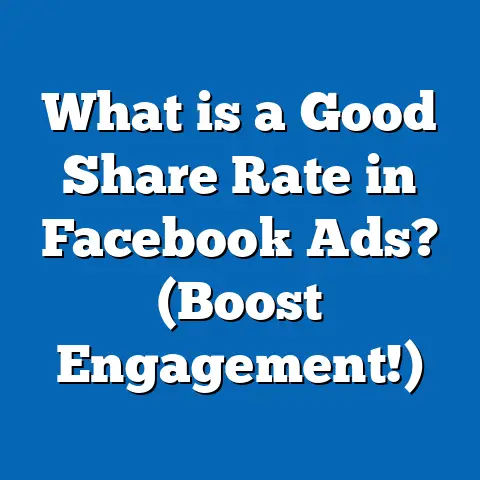What is a DMA in Facebook Ads? (Unlock Targeting Secrets)
Introduction
Did you know that over 2.91 billion people worldwide use Facebook every month? This means that almost one-third of the global population is accessible through Facebook’s advertising platform. For marketers and business owners, this represents one of the biggest opportunities ever to reach potential customers. However, with such a vast audience, the challenge lies in targeting the right people. Poor targeting leads to wasted ad spend, low engagement, and disappointing returns.
This is where understanding DMA — or Designated Market Area — targeting becomes crucial. DMA targeting unlocks a powerful layer of geographic precision that can significantly improve your campaign outcomes by focusing your ads on specific regions where your audience truly lives and consumes media.
What Is a DMA in Facebook Ads?
Understanding the Concept of a DMA
The term DMA, or Designated Market Area, was originally created by Nielsen Media Research as part of their television audience measurement system. A DMA defines a geographic area where people receive similar television programming and exhibit similar media consumption behaviors.
- Each DMA includes a collection of counties or neighborhoods that are grouped together based on where residents typically watch TV stations.
- DMAs are designed to reflect local media markets rather than strict political boundaries like states or cities.
- For example, the New York DMA covers not just New York City but also surrounding counties that share viewership patterns.
DMAs in the Context of Digital Advertising
With the growth of digital advertising platforms like Facebook, marketers wanted more granular geographic targeting than just countries or cities. Facebook integrated DMA data to allow advertisers to target audiences based on these media market regions.
- Instead of just targeting “New York City” or “California,” advertisers can target specific DMAs that align more closely with consumer behavior.
- This helps advertisers reach audiences that share common cultural and media habits, which often translate into buying behaviors.
- Facebook sources DMA boundaries from Nielsen and overlays this data on its users’ location information.
How Many DMAs Are There?
In the United States alone, there are 210 designated DMAs, covering all media markets from large metropolitan areas to smaller regional clusters. Other countries may have similar geographic segmentation systems but may vary in number and definition.
Why Does DMA Targeting Matter in Facebook Ads?
The Limits of Traditional Geographic Targeting
Most advertisers are familiar with location targeting at the country, state/province, city, or ZIP code level. However, each of these has limitations:
- Country-level targeting is too broad for most campaigns and leads to low relevance.
- State-level targeting may include both urban and rural areas with very different audiences.
- City-level targeting focuses on urban centers but ignores adjacent suburban areas that may be important.
- ZIP code targeting is very granular but can be cumbersome to manage at scale.
The Advantage of DMA Targeting
DMA targeting offers a middle ground between large state-level targeting and hyper-local ZIP code targeting. It groups together consumers based on real-world media behaviors rather than administrative boundaries.
- This means your ads are shown to people who consume similar types of media and share cultural habits.
- For businesses with regional marketing strategies or multi-location stores, it allows more precise budget allocation.
- Marketers can improve relevance and reduce wasted spend by focusing only on high-potential DMAs.
Statistical Insight: Impact on Campaign Performance
According to research from Nielsen and Facebook:
- Advertisers who used DMA targeting reported an average increase of 20%-30% in click-through rates (CTR) compared to state-level targeting.
- ROI improved by an average of 15%, driven by higher engagement and conversions.
- Local businesses using DMA-based campaigns saw an increase of up to 25% in foot traffic compared to broader geographic campaigns.
This data underscores that understanding and using DMA can dramatically enhance your Facebook advertising effectiveness.
How Does Facebook Use DMA Data for Ad Targeting?
The Integration Process
Facebook integrates Nielsen’s DMA definitions into its ad platform by mapping DMAs onto its user base using:
- Location data from user profiles
- IP addresses
- Mobile device GPS signals
- Behavioral signals linked to media consumption patterns
This allows Facebook to classify users into DMAs accurately.
Finding and Selecting DMAs in Facebook Ads Manager
Here’s how advertisers can access DMA targeting:
- Open Facebook Ads Manager.
- In the Audience section during ad setup, click on Locations.
- In the location search box, type in the name of the desired DMA (e.g., “Chicago DMA”).
- Select the DMA from the drop-down list; you can add multiple DMAs for broader reach.
- Combine DMA selection with other filters like age, gender, interests for precise audience definition.
Geographic Targeting Options Related to DMAs
Facebook offers several location targeting types you can combine with DMAs:
- People living in this location
- People recently in this location
- People traveling in this location
Choosing “People living in this location” usually yields the best results for local or regional campaigns.
Detailed Benefits of DMA Targeting in Facebook Ads
1. Higher Relevance Through Media Market Alignment
Because DMAs are designed around shared media consumption habits:
- Ads resonate better as they align with cultural preferences.
- There is less chance of irrelevant ads reaching users who are unlikely to convert.
- Example: A sports apparel brand targets sports-focused DMAs rather than general urban areas.
2. Cost Efficiency and Reduced Ad Waste
Focusing your ad spend on high-potential DMAs reduces wasted impressions.
- Campaign costs per click (CPC) tend to be lower because Facebook optimizes delivery within targeted DMAs.
- Cost per acquisition (CPA) can drop by up to 20% compared to broader geo-targeting.
3. Improved Offline and Online Marketing Integration
Many brands run offline campaigns (TV, radio) based on DMAs. Using Facebook’s DMA targeting helps create synergy between offline and online efforts:
- Reinforces brand messaging across channels.
- Boosts consumer response by consistent multi-touch exposure.
4. Scalability Across Multi-Market Campaigns
For brands operating in multiple regions or states:
- DMA targeting simplifies campaign management by grouping locations logically.
- Allows tailored messaging per DMA reflecting local preferences or promotions.
Case Studies: Real-World Applications of DMA Targeting
Case Study 1: Multi-City Restaurant Chain Increases Local Engagement
A restaurant chain with locations in five major metropolitan areas used DMA targeting to promote local events and menu specials.
- Instead of blanket state campaigns, ads were tailored per DMA.
- Result: Online reservations increased by 28% within targeted DMAs.
- Foot traffic rose by 20% compared to previous year’s statewide campaigns.
Case Study 2: Automotive Dealer Network Boosts Test Drives
A national car dealership network aligned its digital ads with TV broadcast DMAs.
- They allocated budget dynamically based on historical sales data by DMA.
- Result: Test drives increased by 40% in target DMAs.
- Overall lead generation costs dropped by 22%.
Case Study 3: Political Campaigns Focus Resources on Swing DMAs
A political campaign targeted swing states’ key DMAs rather than entire states.
- Focused ads on specific media markets more likely to sway undecided voters.
- Result: Improved voter engagement rates by 15%.
Deep Dive: Comparing Geographic Targeting Methods on Facebook
| Targeting Method | Description | Pros | Cons | Best Use Case |
|---|---|---|---|---|
| Country | Target entire countries | Simplest; large reach | Very broad; low relevance | Brand awareness campaigns |
| State/Province | Target entire states/provinces | Moderate granularity | Includes diverse urban/rural mix | Regional promotions |
| City | Target specific cities | More precise urban focus | May exclude suburbs | Local events or store openings |
| ZIP Code | Target postal codes | Highly granular | Difficult at scale | Hyper-local retail promotions |
| DMA (Designated Market Area) | Media market-based regions | Aligns with actual media consumption | Limited to certain countries | Multi-location businesses; media-aligned ads |
DMA targeting is unique because it groups consumers based on where they watch TV and consume media instead of political boundaries alone. This often results in better alignment with purchasing habits.
How to Use DMA Targeting Effectively: Practical Tips
Layer Audience Filters for Precision
Combine DMA targeting with:
- Age
- Gender
- Interests
- Purchase behavior
- Device use (mobile/desktop)
This multi-dimensional approach improves relevance.
Create Custom Audiences Within DMAs
Upload customer lists segmented by location to build Custom Audiences within specific DMAs for retargeting campaigns.
Utilize Lookalike Audiences Based on DMA Customers
Generate Lookalike Audiences from your best customers within each DMA to find new prospects resembling local buyers.
Track Performance Metrics by DMA
Use Facebook’s breakdown reports to analyze:
- Click-through rates (CTR)
- Conversion rates
- Cost per result per individual DMA to identify top-performing regions.
Adjust Budgets Based on DMA Performance
Shift ad spend dynamically toward higher-performing DMAs for optimal ROI.
Technical Insights: How Facebook Maps Users to DMAs
Facebook determines user location through:
- Profile Location Data: User-provided city/state information.
- IP Address Data: Internet connection points indicate general location.
- Mobile GPS/Location Services: For users who allow location tracking via mobile devices.
- Behavioral Signals: Patterns like check-ins, events attended, or content viewed associated with specific geographies.
This multi-layered approach ensures accurate assignment to a designated market area even if exact addresses aren’t available.
Industry Trends Impacting DMA Targeting
Post-Pandemic Shifts in Local Behavior
COVID-19 changed where people live and shop:
- Increased suburban migration altered traditional DMA compositions.
- Marketers need updated data reflecting these shifts for accurate targeting.
Advances in AI-Powered Geo-Targeting
Facebook increasingly uses machine learning to predict which DMAs will perform best based on past campaign data.
Cross-Platform Consistency
Facebook’s integration with Instagram and Audience Network allows consistent DMA-based campaigns across multiple platforms.
Privacy Regulations and Data Availability
Stricter privacy laws like GDPR affect location data usage; however, aggregate DMA data remains usable without compromising user privacy.
Common Questions About DMA Targeting on Facebook
Can I Use DMA Targeting Outside the United States?
DMA definitions are most developed in the U.S., but some international markets have similar media market segmentation. Check Facebook’s available location options per country when setting up campaigns.
How Often Are DMAs Updated?
Nielsen updates their DMA definitions periodically based on changes in media consumption patterns; Facebook syncs these updates accordingly.
Can I Combine DMA Targeting With Other Location Targets?
Yes, you can layer DMA targeting with city or ZIP code targeting for even finer control.
Summary and Strategic Takeaways
DMA targeting is a powerful tool that adds a layer of media market-based geographic precision to your Facebook Ads campaigns. By understanding what a DMA is and how to leverage it properly:
- You improve ad relevance through culturally aligned regions.
- Reduce wasted ad spend by excluding irrelevant areas.
- Enhance integration between offline media campaigns and digital efforts.
- Gain actionable insights by analyzing performance at the market level.
Action Plan: How to Start Using DMA Targeting Today
- Audit Your Business Geography: Identify if your customers cluster around specific DMAs.
- Test Small Campaigns: Run split tests comparing state-level vs. DMA-level targeting.
- Analyze Results: Use Facebook reporting tools to evaluate CTR, CPA, ROAS per DMA.
- Refine Audiences: Layer demographic and interest filters onto your best-performing DMAs.
- Align Offline & Online Media: Coordinate TV/radio buys with Facebook DMA-targeted ads.
- Scale Successful Campaigns: Expand budget allocation toward top-performing markets.
Appendix: List of Top US DMAs (Examples)
| Rank | DMA Name | Key Cities Included |
|---|---|---|
| 1 | New York | NYC, Newark |
| 2 | Los Angeles | LA, Long Beach |
| 3 | Chicago | Chicago |
| 4 | Philadelphia | Philadelphia |
| 5 | Dallas-Fort Worth | Dallas, Fort Worth |
(There are 210 total DMAs across the U.S.)
Would you like me to prepare downloadable guides/templates for implementing these strategies?





